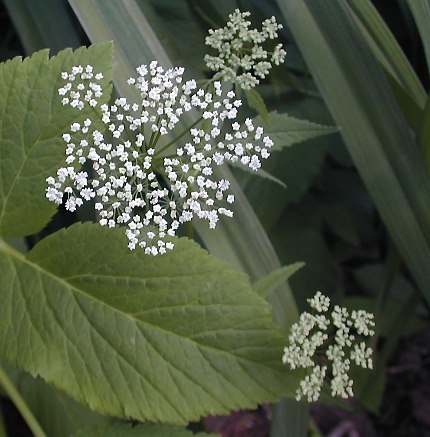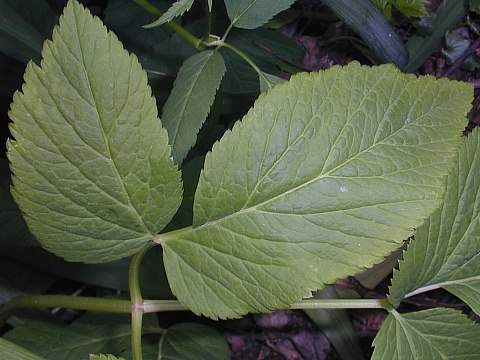
The stalks terminate in compound umbels of flowers about 1½-3½" across that are flat-topped. Each compound umbel is divided into 10-20 umbellets, while each umbellet is divided into 10-25 flowers. The compound umbels lack floral bracts and the umbellets lack floral bractlets. Individual flowers are about 1/8" (3 mm.) across, consisting of 5 white petals with incurved tips and an inferior ovary with a pair of styles. The peduncles of the compound umbels are 3-6" long, light green, glabrous, angular, and grooved. The pedicels of individual flowers are about ¼" in length, light green, and glabrous. The blooming period occurs from late spring to mid-summer, lasting about 1 month. The flowers are replaced by ovoid-oblongoid fruits that are ridged and somewhat flattened; they are about 1/8" (3 mm.) long and release their seeds at maturity during the autumn. The root system is fibrous and rhizomatous. Goutweed often forms clonal colonies from the spreading rhizomes.
Cultivation: The preference is partial sun to light shade, moist to mesic conditions, and soil containing loam, clay-loam, or sandy loam. This plant has few problems with either insects or disease organisms. It can spread aggressively, particularly in locales with cool moist climates.

Range & Habitat: So far, Goutweed has rarely escaped from cultivation and become naturalized in Illinois. It has been found as an escaped plant in only a few counties of NE Illinois (see Distribution Map). Because of its aggressive nature, Goutweed may become more common in the future. It was introduced into North America from Eurasia as an ornamental plant. Habitats include deciduous woodlands (sandy & non-sandy), shaded ravines, woodland borders, cemeteries, roadsides, and waste areas. Cultivated forms of Goutweed include those with variegated and non-variegated leaves. However, wild specimens of Goutweed almost always have non-variegated leaves.
Faunal Associations: Floral-faunal relationships for this plant in North America are poorly understood. Müller (1873/1883) observed miscellaneous flies, beetles, wasps, small bees, and sawflies visiting the flowers for either nectar or pollen in Germany. Apparently the young foliage of Goutweed is considered edible to humans as it has been used in the Old World as a source of food and a medicinal herb.

Photographic Location: A flower garden in Urbana, Illinois.
Comments: Like many other species in the Carrot family, Goutweed has compound umbels of small white flowers and compound leaves. It can be identified by the absence of floral bracts and bractlets underneath its flowers, and by the structure and shape of its leaves. Generally, its compound leaves have ternately arranged leaflets (divided into groups of 3), although the leaflets within a group sometimes occur in pairs. Compared with many other species in the Carrot family, these leaflets are relatively large in size and relatively broad in shape when one considers the size of the plant. Among native wildflowers, Honewort (Cryptotaenia canadensis) is similar in appearance to Goutweed, but the flowers of Honewort are even smaller in size and its compound leaves have only 3 leaflets, rather than 3 groups of leaflets.